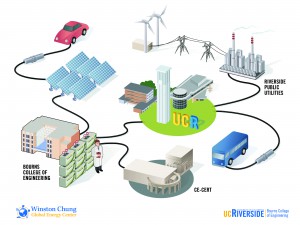The University of California, Riverside has launched its Sustainable Integrated Grid Initiative to research the integration of intermittent renewable energy including photovoltaic solar panels, energy storage including batteries, and all types of electric and hybrid electric vehicles. The project is the largest of its kind in the state.
California, Riverside has launched its Sustainable Integrated Grid Initiative to research the integration of intermittent renewable energy including photovoltaic solar panels, energy storage including batteries, and all types of electric and hybrid electric vehicles. The project is the largest of its kind in the state.
“This project puts UC Riverside at the forefront of smart grid and electric vehicle research, providing a unique platform for engineers and utilities to identify and solve potential problems at scale,” said Matthew Barth, lead investigator of the initiative and the director of UC Riverside’s Bourns College of Engineering Center for Environmental Research and Technology (CE-CERT).
The testbed is located at CE-CERT and includes:
- Four megawatts of solar photovoltaic panels. Three-and-a-half megawatts will be at UC Riverside’s main campus. The remaining half megawatt is at CE-CERT about two miles from campus.
- Two megawatt-hours of battery energy storage. The batteries will store energy for distribution during periods when there is insufficient solar power generation. One megawatt is at CE-CERT and the additional megawatt is located in Winston Chung Hall on UC Riverside’s main campus.
- Twenty-seven electric vehicle charging stations. Eight chargers, with level two capabilities, which are suitable for cars, are in parking lots on UC Riverside’s main campus. Four level two chargers and one level three charger, which is suitable for larger vehicles, are located at CE-CERT. In addition, 14 level two chargers are located throughout the city of Riverside.
- A UCR-owned and RTA-operated trolley bus that has been converted from diesel combustion to battery electric operation.
- Energy monitoring, management and control tools developed by UC Riverside engineering students to ensure energy grid stability, reliability and efficiency.
On average California derives two-thirds of its electricity from fossil fuels such as coal and natural gas, and the majority of vehicles in the state are powered by imported oil. Introducing renewable electricity generation and electric vehicle technologies such as plug-in hybrids are two key priorities in California. To achieve these priorities, utilities will need to bring a significant number of fast charging electric vehicles onto the grid without distribution or affecting reliability – especially during peak times. This project will demonstrate that this can be done with the existing grid through “smart integration” of renewable energy, storage and advanced dispatch controls.

